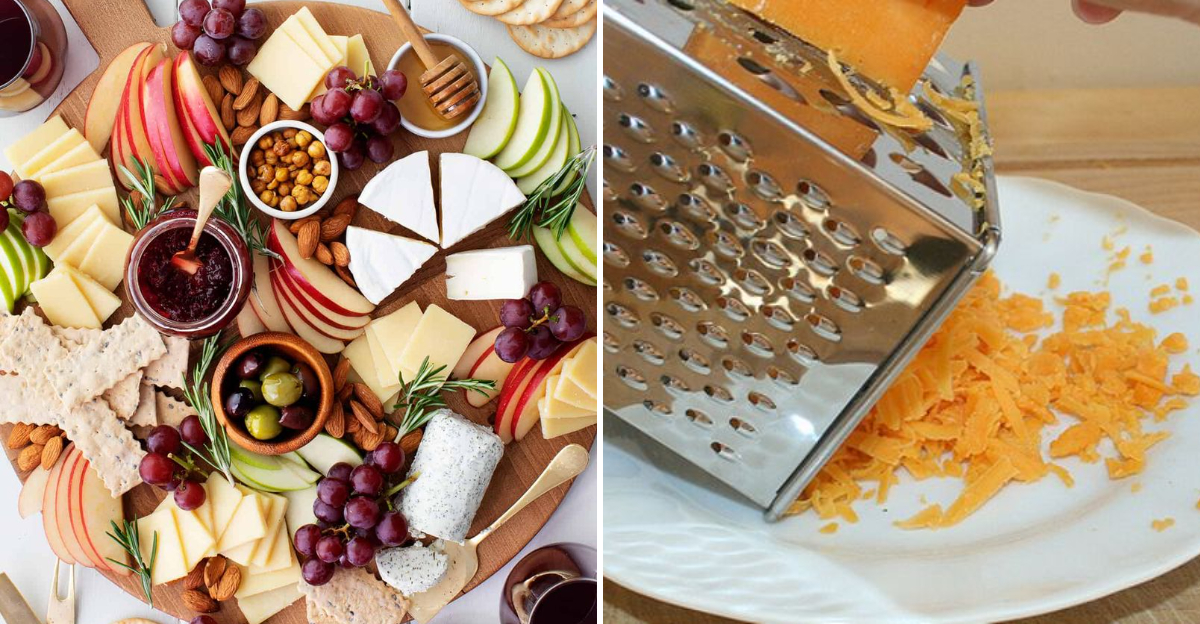8 Common Big Mistakes Many Make When Cooking With Cheese

I’ve always considered myself a cheese aficionado, but boy, have I made some embarrassing blunders in my kitchen adventures!
Cheese seems simple enough to cook with – melt it, spread it, sprinkle it – but there’s actually quite a bit of science behind getting those gooey, delicious results we all crave.
Whether you’re making mac and cheese, pizza, or a fancy fondue, these common cheese cooking mistakes might be sabotaging your culinary masterpieces.
1. Grabbing The Wrong Cheese For The Job
Last Thanksgiving, I attempted to make a cheese sauce with aged cheddar that separated into an oily mess! Not all cheeses are created equal when it comes to melting. Hard, aged cheeses like Parmesan or aged cheddar contain less moisture and more fat, making them prone to becoming grainy or oily when heated.
Soft, young cheeses like mozzarella, Monterey Jack, and Gruyère are your melting champions. They contain more moisture and melt into that smooth, stretchy texture we dream about. For those creamy cheese sauces, American cheese actually works wonders because it contains emulsifiers.
Remember this simple rule: if you want something melty, go young and moist. If you need something with concentrated flavor for grating on top of a finished dish, the aged varieties shine!
2. Skipping The Fresh Grating Step
I used to think pre-shredded cheese from bags was the greatest time-saver ever invented! Then I wondered why my cheese sauce always had a slightly gritty texture. Here’s the cheese truth bomb: pre-shredded cheese contains anti-caking agents like cellulose powder or potato starch that prevent it from clumping in the bag.
These additives also interfere with proper melting, creating a less creamy result. Plus, those packaged shreds often dry out in the bag, further compromising their meltability and flavor.
Take those extra 30 seconds to grate your cheese fresh from the block. Your taste buds will thank you with each gloriously smooth, creamy bite. The difference is especially noticeable in dishes where cheese is the star, like mac and cheese or quesadillas.
3. Cranking The Heat Too High
My first attempt at homemade fondue turned into a rubbery, separated disaster because I got impatient and cranked up the heat! Cheese is primarily made of proteins, fat, and water, and these components break apart when exposed to high temperatures. The proteins bond together and squeeze out the fat, resulting in that greasy, clumpy mess we’ve all experienced.
Low and slow is the golden rule when melting cheese. Gentle heat allows the proteins to relax and the emulsification to happen properly. For stovetop cooking, a double-boiler setup works wonders by providing indirect heat.
Even microwaving cheese requires care – use 50% power and short intervals with plenty of stirring breaks. Your patience will be rewarded with silky smooth results instead of tough, stringy disappointments.
4. Rushing To Add Cheese Too Early
Confession time: I once ruined a perfectly good pot of risotto by dumping in Parmesan while the rice was still hard and brothy. Rookie mistake! Adding cheese too early in the cooking process can lead to disaster, especially in dishes with high moisture content like soups, sauces, and stews.
When cheese sits in hot liquid for too long, it can curdle, become stringy, or completely dissolve and lose its flavor impact. Cheese should typically be one of the final ingredients added to your dish, often off the heat entirely.
For soups and sauces, wait until the very end of cooking, reduce the heat, and add cheese gradually while stirring. With pasta dishes, toss the cheese with the hot pasta after draining but before adding any reserved cooking water for adjusting consistency.
5. Forgetting The Magic Of Starch In Cheese Sauces
My first attempt at mac and cheese without a recipe was a spectacular failure – the cheese slid right off the pasta in an oily puddle! The missing ingredient? A starch binder. Cheese naturally wants to separate when heated, and without something to hold those proteins and fats together, you’ll end up with a broken, greasy mess.
A roux (butter and flour cooked together) creates the perfect foundation for cheese sauces. The starch molecules in flour literally wrap around the fat molecules, creating a stable emulsion. No time for a roux? Even a quick slurry of cornstarch and cold water or milk can work wonders.
For fondue, traditionalists use cornstarch or the natural starch in certain wines. Even sodium citrate (the secret ingredient in processed cheese) can transform any cheese into a smooth-melting dream for modernist home cooks.
6. Making Fondue Without A Stabilizer
My Swiss friend nearly disowned me when I tried making fondue without cornstarch! “Mon Dieu! What are you doing?” she exclaimed. Turns out, cheese fondue’s silky texture doesn’t happen by magic – it needs help staying together at high temperatures.
Traditional Swiss fondue recipes call for tossing the grated cheese with cornstarch before melting. This isn’t just culinary superstition; the starch coats the cheese proteins and prevents them from clumping together when heated. The acid in the wine or lemon juice also helps by relaxing the protein structure.
Without these stabilizers, your beautiful melted cheese can quickly transform into a stringy, separated mess. For foolproof fondue, always use a combination of cornstarch and acidic liquid. And remember to keep the heat gentle throughout – no bubbling allowed!
7. Matching Cheese With Flavor-Clashing Ingredients
The dinner party disaster I’ll never live down? Serving a delicate, expensive brie smothered in spicy buffalo sauce. The heat completely overwhelmed the cheese’s subtle flavor – money and good cheese down the drain! Not all flavor combinations work with cheese, and understanding which ingredients complement rather than compete is crucial.
Delicate, soft cheeses like brie and camembert pair beautifully with subtle flavors – think honey, mild fruits, and nuts. Bold, aged cheeses can stand up to stronger companions like caramelized onions, hearty meats, or robust wines.
Acidity is your friend – ingredients like tomatoes, vinaigrettes, and wine help cut through cheese’s richness. But beware of overwhelming spice levels that can numb your palate to the cheese’s nuances. The perfect pairing should create balance, with neither component overshadowing the other.
8. Neglecting Proper Cheese Storage Before Cooking
“Why is my cheese blue where it shouldn’t be?” I once wondered aloud, examining what was supposed to be a white cheddar. How you store cheese before cooking significantly impacts its flavor, texture, and performance when heated. Plastic wrap is actually cheese’s enemy – it prevents proper breathing and encourages unwanted moisture.
For the best cooking results, store cheese in specialized cheese paper, parchment paper, or wax paper, which allows it to breathe while maintaining humidity. Always keep cheese in the vegetable crisper drawer, where temperature remains more consistent than the main refrigerator compartment.
Remember to bring cooking cheese to room temperature before using it. Cold cheese melts unevenly and can seize up when shocked by heat. These simple storage steps make a remarkable difference in how your cheese performs in recipes.
